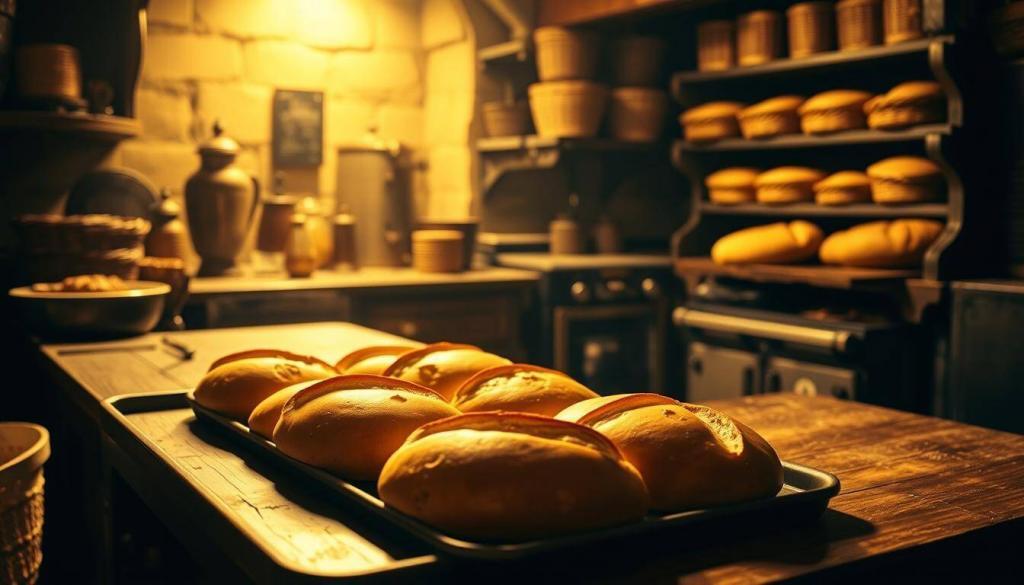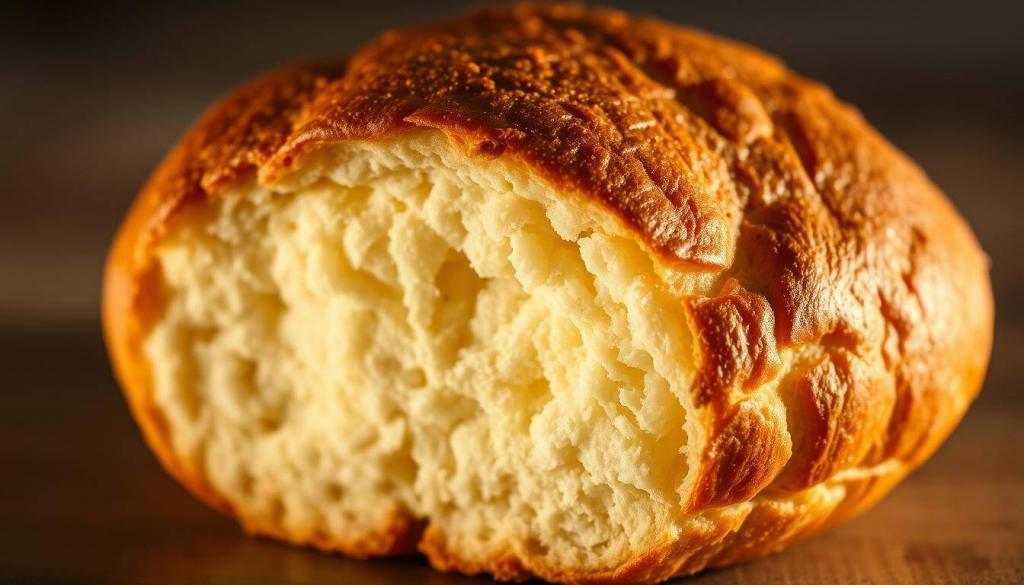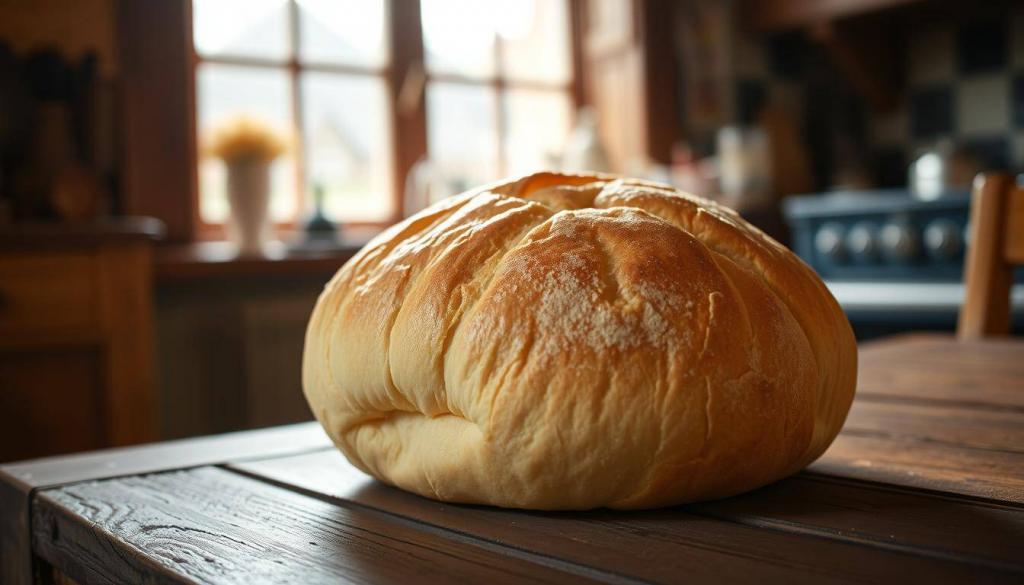Waterford Blaa: Traditional Irish Bread
Steeped in history and tradition, the Waterford Blaa is a cherished Irish bread roll that holds a special place in the hearts of locals. Known for its soft texture and flour-dusted top, this roll is a symbol of regional pride and culinary craftsmanship. Its unique double proofing process ensures a light and airy consistency, setting it apart from other bread varieties like baps or hamburger buns1.
Originating in County Waterford, this bread roll has become a staple in local bakeries and households. Its production is strictly confined to the region, ensuring authenticity and preserving its heritage1. With two varieties available—soft and crusty—it caters to diverse tastes while maintaining its traditional identity2.
Join us as we explore the story behind this iconic Irish creation, celebrating the skill and dedication of the bakers who bring it to life. From its storied past to its modern-day significance, the Waterford Blaa is more than just a bread roll—it’s a piece of Irish culture.
The Storied History of the Waterford Blaa
Rooted in the late 17th century, the story of this iconic bread roll begins with the arrival of French Huguenots. These refugees brought with them a simple dough pastry, which would later evolve into the beloved roll we know today3. Their influence laid the foundation for a culinary tradition that has endured for centuries.

By the 18th century, baking practices in the city had transformed this humble pastry into a staple enjoyed from early morning until late day4. Family-run bakeries, such as Walsh’s Bakehouse and Barron’s Bakery, played a crucial role in preserving and refining the recipe. Their dedication ensured that the roll remained a symbol of local pride.
Huguenot Beginnings and Early Traditions
The Huguenots’ arrival in the city marked the beginning of a rich baking heritage. Their recipe, characterised by its soft texture and flour-dusted top, quickly became a favourite among locals4. This early tradition set the stage for the roll’s evolution into a cultural icon.
Evolution into a Heritage Icon
Over time, the roll became deeply ingrained in the city identity. The formation of the Blaa Bakers Association was a pivotal moment, safeguarding the tradition and ensuring its authenticity4. Today, it stands as a testament to the skill and dedication of generations of bakers, a true heritage icon.
Traditional Baking Techniques and Authentic Processes
The art of crafting this iconic bread roll lies in its meticulous baking techniques. Every step, from mixing the dough to the final bake, is carefully designed to achieve its signature texture and flavour. These methods have been passed down through generations, preserving the authenticity of the process5.

Double Proofing: The Key to Perfect Rolls
One of the most critical steps is the double proofing process. This involves allowing the dough to rise twice, which enhances its structure and flavour. The first proof gives the yeast time to activate, while the second ensures a light and airy texture6.
Using high-protein flour and active dry yeast, bakers create a strong yet soft dough. The fermentation time is crucial, as it allows the flavours to develop fully. This attention to detail is what sets these rolls apart7.
The Unique Role of Flour Dusting and Oven Craft
Another defining feature is the liberal dusting of flour on top. This not only gives the rolls their distinctive appearance but also prevents sticking during baking. The skill lies in ensuring the top remains white and appealing even after it leaves the oven5.
The oven plays a vital role in achieving the perfect balance of textures. A crisp bottom contrasts beautifully with the soft interior, creating a delightful eating experience. Traditional techniques, like precise temperature control, ensure consistency in every batch6.
From the careful mixing of ingredients to the final proof, every step in the process contributes to the celebrated taste and structure of these rolls. It’s a testament to the skill and dedication of the bakers who keep this tradition alive7.
Authentic Waterford Blaa Recipe and Craftsmanship
Crafting the perfect roll requires a blend of tradition, skill, and the finest ingredients. Drawing on detailed recipes from local sources, we’re excited to share an authentic recipe that captures the essence of this beloved bread. Whether you’re a seasoned baker or a novice, this guide will help you create rolls that are soft, fluffy, and dusted with just the right amount of flour.

Essential Ingredients and Time-Honoured Methods
The foundation of this recipe lies in its simple yet high-quality ingredients. Strong bread flour, active dry yeast, salt, and a touch of sugar come together to form a dough that’s both elastic and smooth. Kneading by hand is crucial, as it develops the gluten and ensures the perfect texture8.
One of the most critical steps is the double proofing process. After the first rise, the dough is shaped into rolls and left to rise again. This method ensures a light and airy interior, a hallmark of this traditional bread9.
Our Tips from Experienced Bakers
Seasoned bakers emphasise the importance of patience and precision. The dough should rise for about 40 to 45 minutes before shaping, and the shaped rolls need an additional 45 to 50 minutes before baking8. Dusting each roll with flour not only protects it from the oven’s heat but also gives it that iconic appearance.
Small adjustments, like the amount of yeast or the rising time, can make a big difference. These rolls are a labour of love, reflecting the dedication of generations of family bakers who have kept this tradition alive9.
Once baked, these rolls are best enjoyed fresh, slathered with butter or filled with crispy bacon. We encourage you to try this recipe at home, embracing the process as much as the delicious result.
Local Significance and Cultural Traditions in Waterford
In the heart of Ireland’s oldest city, a humble bread roll has become a symbol of local pride and tradition. This iconic food is more than just a breakfast item; it’s a cultural cornerstone that connects generations. Its story is deeply intertwined with the history of Waterford city and county, making it a cherished piece of our heritage10.

PGI Status and the Blaa Bakers Association
In 2013, this bread roll received Protected Geographical Indication (PGI) status from the European Union, ensuring its authenticity and quality11. Only products made in Waterford city and county can bear its name, a testament to its unique regional identity. The Waterford Blaa Bakers Association plays a vital role in maintaining these standards, preserving the traditional methods that make this roll so special11.
Today, two main bakeries continue this legacy: Walsh’s Bakehouse, established in 1921, and Hickey’s Bakery, run by the third generation of the Hickey family11. Their dedication ensures that every piece of this bread roll reflects the skill and passion of its creators.
Family Heritage and Community Celebrations
This bread roll is not just a snack; it’s a symbol of family heritage. Many locals have fond memories of enjoying it fresh from the bakery, often as a hearty breakfast or a mid-day treat11. Its soft texture and flour-dusted top make it a favourite across the city county.
Community celebrations often feature this iconic roll, showcasing its role in local traditions. Whether enjoyed plain with butter or filled with crispy bacon, it remains a beloved piece of our culinary culture11. Its enduring popularity today is a testament to the pride and dedication of the waterford blaa bakers who keep this tradition alive.
Final Reflections on Our Journey with Irish Bread
Our journey through the world of traditional Irish bread has been a celebration of heritage and craftsmanship. From sourcing quality wheat and salt to the final dusting on the top of a freshly baked roll, every step contributes to a unique product12.
This bread is more than just food; it’s a vital part of our culinary heritage. The role of water and natural ingredients is essential in defining its signature flavour and texture13.
Preserving traditional methods ensures every word and detail of the process is respected. It’s not just about making bread but about keeping a cherished cultural art form alive14.
We invite you to take part in continuing this rich tradition. Each roll is a harmonious part of a time-honoured recipe, reflecting creativity and respect in every step.
Source Links
- How to Make Waterford Blaas (Authentic Irish Rolls Recipe) Recipe – https://www.biggerbolderbaking.com/how-to-make-waterford-blaas/
- Blaa – https://en.wikipedia.org/wiki/Blaa
- All around Ireland | Ireland.com – https://www.ireland.com/en-us/plan-your-trip/trip-ideas/all-around-ireland/
- REGIONAL SPECIALTIES: UNIQUE DISHES FROM ACROSS IRELAND – https://irishfoodhub.com/regional-specialties-unique-dishes-from-across-ireland/
- Regional Irish Foods -The Waterford Blaa And Where To Find Them – https://goodfoodireland.ie/regional-irish-foods-the-waterford-blaa-and-where-to-find-them/
- Waterford Blaa Recipe (Irish Bread Rolls) – https://hostessatheart.com/waterford-blaa/
- Waterford Blaas (Irish Rolls) – https://savortheflavour.com/waterford-blaa-buns/
- The Waterford Blaa | Irish Breads – https://www.karenskitchenstories.com/2016/03/the-waterford-blaa-twelveloaves-irish.html
- Corned Beef, Guinness And … Blaa? The Irish Bread You Never Knew About – https://www.kpbs.org/news/2016/03/15/corned-beef-guinness-and-blaa-the-irish-bread-you
- Ireland’s Oldest City – Visit Waterford – https://visitwaterford.com/irelands-oldest-city/
- The bread that changed how the Irish eat breakfast – https://www.bbc.com/travel/article/20180205-how-waterford-blaa-changed-breakfast-in-ireland
- Going the way of the blaa – https://www.irishtimes.com/news/going-the-way-of-the-blaa-1.596142
- A Little History Of Irish Bread – https://goodfoodireland.ie/blog/a-little-history-of-irish-bread/
- Blaas from the past: Sourdough is on the rise but it has history here – https://www.irishtimes.com/food/2023/12/25/blaas-from-the-past-sourdoughs-on-the-rise-but-it-has-history-here/
Footer 1
Call the HERD
Always available for any questions. Call and we will be happy to help.
Follow the HERD
Keep up to date on new products available in store.
Important Links
Join the HERD
Be the first to know about any offers or promotions.
- Herd Butchery 2025

Leave a Reply